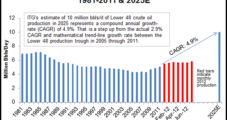Lower 48 onshore oil and gas reserves are a huge energy pond, about 1.1 Qcfe worth, and the Marcellus Shale is its biggest fish. According to new research from Calgary-based ITG Investment Research, “the Marcellus dwarfs any other resource at 330 Tcfe, followed by the Eagle Ford and Bakken [shales] at 152 Tcfe (25 billion boe) and 72 Tcfe (12 billion boe), respectively.
Compound
Articles from Compound
Apache Deal More than Doubles Liquids Acreage in Anadarko Basin
Apache Corp. is picking up 254,000 net acres in the Granite Wash, Tonkawa, Cleveland and Marmaton plays in Oklahoma and Texas with estimated proved reserves of 71.5 million boe through a $2.85 billion deal to acquire privately held Cordillera Energy Partners III LLC, the Houston-based company said Monday.
Lawmaker: Study Understated Risks to Barnett Residents
People living near Barnett Shale gas production facilities could be at risk for immune system damage from toxic air emissions, and the risk is likely understated by an air quality study completed for the city of Fort Worth earlier this year, a state lawmaker warned Mayor Betsy Price in a letter.
Industry Brief
The U.S. Department of Energy’s (DOE) Hanford nuclear compound in Washington state is in the very early stages of planning to run a six-inch diameter natural gas pipeline under the Columbia River to supply a massive wastewater treatment plant during the next eight years. The 28.5-mile, $22 million project would be facilitated with the local utility Cascade Natural Gas Co., tying into its existing pipeline system on the Oregon side of the river and then connecting to the still-to-be-built water treatment facility. The plant was originally planned to operate with diesel, but the proposed pipeline would permit it to have dual fuel capability, operating mostly on natural gas, a Hanford facility spokesperson said. The gas line would provide more cost savings and environmental advantages, greatly reducing the proposed plant’s greenhouse gas emissions. “The gas also can help support steam generation for [onsite] electricity and also heat for 11 different facilities,” he said. Plans call for the pipeline to be permitted and built during the next four years, and the wastewater plant to begin operation in 2019, turning high-level waste into glass. “It’s really a glass-making plant,” the spokesperson said.
EPA Considering Ways to Test Emissions at Oil, Gas Facilities
Federal and state air quality agencies are considering how to best estimate and measure the level of volatile organic compound (VOC) emissions from oil and natural gas facilities, and field testing in some western states may begin within a year to consider whether additional regulations are needed, an Environmental Protection Agency (EPA) official said.
EPA Considering Ways to Test Emissions at Oil, Gas Facilities
Federal and state air quality agencies are considering how to best estimate and measure the level of volatile organic compound (VOC) emissions from oil and natural gas facilities, and field testing in some western states may begin within a year to consider whether additional regulations are needed, an Environmental Protection Agency (EPA) official said.





